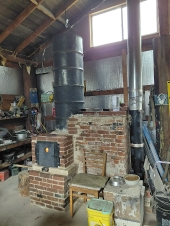


Clean With Cleaners You Can Eat by Raven Ranson
will be released to subscribers in:
soon!



Mark Reed wrote:I don't know what a rocket mass heater is... <edited post... you can read his entire post above>
...Basically, I just don't believe a lot of the documentation on the effectiveness and safety of some rocket mass heaters.


Rico Loma wrote:I agree, specifically with William, about insurance costs and related bedevilment. My old style wood burner is inefficient, yes, but can handle a 32 inch log. At least my sawing and splitting is half the effort of many folks here. And my home insurance only covers this type, not any hand made stove. The company could cancel my policy at any time for any reason....happened to a friend less than a mile away. New Mexico has rough weather at times, I know, but in GA insurance companies are averse to our 100 year old house enduring hazards like hurricanes, tornados and tropical storms from the Atlantic and the Gulf of Mexico.

Matt McSpadden wrote:Currently, I can add a reason, that I do not own the house I am living in. But previously, when I did have a house, it was mostly money.
For me it was primarily the costs. Most realistic estimates that I saw, was near $2000 to build one myself. Both houses I owned were up off the ground, so I would have had to add additional supports for additional costs. And perhaps the greatest thing... I was not confident enough that I could build it myself, so that made me feel as though I would need to hire at least a consultant, if not a mason of some kind. And that added even more costs. So while two grand was a big hurdle... the other costs seemed insurmountable.



Jackson Bradley wrote:I get somewhat confused on the longevity of the different parts for the different types.
I can't quite wrap my head around what I'll need to replace/clean, about how often it will need replaced. That seems to depend on the type of RMH. I have read through your masonry build in the large building, the Wisner's materials, Thomas Rubino's projects, etc. I have seen where some of the metal components need to be replaced and some of the bricks crack and need replaced, etc.
I understand a factor of that would be climate dependent due to the amount it would be used (wood burned). The larger masonry heaters seem like what I would work up to in my residence but practice building one on in my accessory building.

